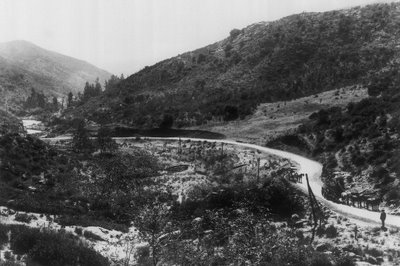There is something fascinating about looking at old photographs of Los Angeles. The city is so young by Euro-standards, so full or energy, so free of the past and focused on the future. In L.A., "old" means a few decades, a couple of generations. The wilderness of the 1920s has become busy, over-crowded neighborhoods with major thoroughfares. And mule paths have turned into 10-lane freeways that never seem to swallow the traffic -- as shown in this new vignette from Los Angeles Then & Now:

The Gabrieleno Indian word cahuenga means "place of the mountain." The Cahuenga Pass was originally an Indian footpath and burial ground. It was also used by the Spanish and Mexicans to drive their cattle across the mountains and was the site of several skirmishes over land use. In 1889 (when the photo above was taken), it was traversed by stagecoaches and mule teams, and at the turn of the century, by cyclists. In 1926, the roadway connecting Hollywood with the San Fernando Valley was completed.

By 1915, the Pacific Electric Railway's Red Cars took passengers through the Cahuenga Pass, which was later paved for bus routes. In 1954, with an increase in traffic, this was expanded and became the route for the new Hollywood Freeway. Today, a narrow road remains on either side of the heavily used freeway. Underneath the Cahuenga Pass, a new subway system is under construction, once again linking Hollywood with the Valley.

No comments:
Post a Comment